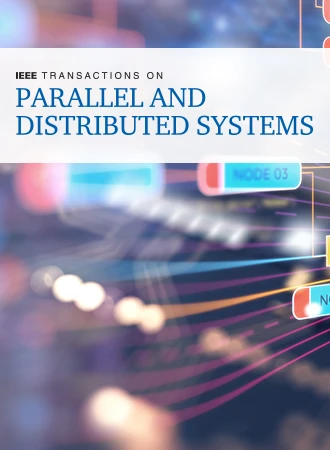Atomic Smart Contract Interoperability With High Efficiency via Cross-Chain Integrated Execution
IF 6
2区 计算机科学
Q1 COMPUTER SCIENCE, THEORY & METHODS
IEEE Transactions on Parallel and Distributed Systems
Pub Date : 2025-09-25
DOI:10.1109/TPDS.2025.3614374
引用次数: 0
Abstract
With the development of Ethereum, numerous blockchains compatible with Ethereum’s execution environment (i.e., Ethereum Virtual Machine, EVM) have emerged. Developers can leverage smart contracts to run various complex decentralized applications on top of blockchains. However, the increasing number of EVM-compatible blockchains has introduced significant challenges in cross-chain interoperability, particularly in ensuring efficiency and atomicity for the whole cross-chain application. Existing solutions are通过跨链集成执行实现高效的原子智能合约互操作性
随着以太坊的发展,出现了许多与以太坊执行环境兼容的区块链(即以太坊虚拟机,EVM)。开发人员可以利用智能合约在区块链上运行各种复杂的分散应用程序。然而,越来越多的evm兼容区块链在跨链互操作性方面带来了重大挑战,特别是在确保整个跨链应用程序的效率和原子性方面。现有的解决方案要么在保证跨链应用程序的整体原子性方面受到限制,要么由于需要多轮跨链智能合约执行而效率低下。为了解决这一差距,我们提出了IntegrateX,这是一个高效的跨链互操作性系统,可确保跨链智能合约调用的整体原子性。其核心思想是将跨链执行所需的逻辑部署到单个区块链上,以便以集成的方式执行。这允许跨链应用程序在同一个区块链中有效地执行所有跨链逻辑。IntegrateX由跨链智能合约部署协议和跨链智能合约集成执行协议组成。前者通过将智能合约逻辑与状态解耦,采用链下跨链部署机制结合链上跨链验证,实现高效安全的跨链部署。后者通过基于2pc的机制确保了跨链调用的原子性,并通过事务聚合和细粒度状态锁增强了性能。我们实现了一个IntegrateX的原型。大量的实验表明,与最先进的基线相比,它可以在保持低气体消耗的同时减少高达61.2%的延迟。
本文章由计算机程序翻译,如有差异,请以英文原文为准。
求助全文
约1分钟内获得全文
求助全文
来源期刊

IEEE Transactions on Parallel and Distributed Systems
工程技术-工程:电子与电气
CiteScore
11.00
自引率
9.40%
发文量
281
审稿时长
5.6 months
期刊介绍:
IEEE Transactions on Parallel and Distributed Systems (TPDS) is published monthly. It publishes a range of papers, comments on previously published papers, and survey articles that deal with the parallel and distributed systems research areas of current importance to our readers. Particular areas of interest include, but are not limited to:
a) Parallel and distributed algorithms, focusing on topics such as: models of computation; numerical, combinatorial, and data-intensive parallel algorithms, scalability of algorithms and data structures for parallel and distributed systems, communication and synchronization protocols, network algorithms, scheduling, and load balancing.
b) Applications of parallel and distributed computing, including computational and data-enabled science and engineering, big data applications, parallel crowd sourcing, large-scale social network analysis, management of big data, cloud and grid computing, scientific and biomedical applications, mobile computing, and cyber-physical systems.
c) Parallel and distributed architectures, including architectures for instruction-level and thread-level parallelism; design, analysis, implementation, fault resilience and performance measurements of multiple-processor systems; multicore processors, heterogeneous many-core systems; petascale and exascale systems designs; novel big data architectures; special purpose architectures, including graphics processors, signal processors, network processors, media accelerators, and other special purpose processors and accelerators; impact of technology on architecture; network and interconnect architectures; parallel I/O and storage systems; architecture of the memory hierarchy; power-efficient and green computing architectures; dependable architectures; and performance modeling and evaluation.
d) Parallel and distributed software, including parallel and multicore programming languages and compilers, runtime systems, operating systems, Internet computing and web services, resource management including green computing, middleware for grids, clouds, and data centers, libraries, performance modeling and evaluation, parallel programming paradigms, and programming environments and tools.
 求助内容:
求助内容: 应助结果提醒方式:
应助结果提醒方式:


